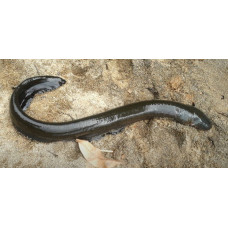Latin name
Electrophorus electricus
Identification
The electric eel has bare skin, no scales, and a very elongated body that is rounded at the front and slightly compressed on the sides at the rear. Eels have a very large swim bladder that can reach 80 cm in length in large specimens. They have a Weberian apparatus that connects their ear to their swim bladder, greatly expanding their hearing capabilities. The lateral line, which is barely noticeable, is located in the upper part of the body. This line contains electrical receptor cells that allow the eel to detect the slightest changes in water pressure.
Interestingly, electric eels have special areas of vascular tissue in their mouths that allow them to absorb oxygen directly from the air. To obtain a new supply of oxygen, the eel must rise to the surface of the water at least once every 15 minutes, though it usually does so more frequently. If deprived of this opportunity, the fish will die. The electric eel's ability to use atmospheric oxygen for breathing enables it to survive out of water for several hours, provided that its body and mouth remain moist. This feature increases the eel's survivability in unfavorable conditions.
Features of fish fins
Dorsal spines (total): 0; Dorsal soft rays (total): 0.
This fish primarily uses its anal fin for movement, while its caudal and pelvic fins are underdeveloped or absent.
Fish colouring
Adult electric eels are olive-brown with a bright orange underside, light-colored edges on their anal fins, and emerald green eyes.
Distribution
They inhabit the rivers of northeastern South America, as well as the tributaries of the middle and lower Amazon.
Habitat
It is a tropical, freshwater, benthopelagic species. It inhabits marshy areas with oxbow lakes and ponds that gradually become overgrown with vegetation and transform into swamps. The eel rests and hides in these murky, dirty waters.
Size
Its maximum body length is 250 cm, and it can weigh up to 20 kg.
Behavior
They are nocturnal.
This species of fish is notable for its electric organs, which account for about four-fifths of its body length. The fish can generate a voltage of up to 860 volts and a current of up to 40 milliamps. The positive pole is located at the front of the body and the negative pole is located at the rear. Eels use electric organs to protect themselves from predators and paralyze prey, mainly small fish. There is also an additional electric organ that acts as a locator. An electric shock from an adult electric eel can stun a horse.
Electric eels use weak electrical signals for navigation and social communication with other eels in darkness or murky water. The eel uses a weak voltage of 10 volts for orientation, and the electric field extends to a radius of five meters. Some electric receptors detect non-electric fish, while others detect signals from their own kind. This ability allows eels to sense the heartbeats of other fish.
Food and feeding habits
The electric eel uses a voltage of 300–600 volts to hunt. An attack consists of four to eight short discharges, each lasting two or three thousandths of a second. When approaching its prey, the eel discharges electricity, causing the pursued fish and all living creatures around it to fall into a stupor. The eel can then choose the most suitable prey. It opens its mouth wide and swallows fish, crabs, and other small animals one after another. While swallowing, it snorts and makes a noise that can be heard from afar.
Juveniles feed on invertebrates, adults feed on fish and small mammals, and first-born larvae feed on other eggs and embryos obtained at the end of spawning.
Reproduction
Almost nothing is known about the reproduction of electric eels.
However, it is known that males build foam nests and guard the growing larvae until mid-January, when the first seasonal rains flood the breeding area. This causes the young eels, which are about 10 cm long, to scatter. Males outnumber females three to one and are significantly larger than them. During the spawning period, females lay three batches of eggs in succession. However, not all eels with fully developed gonads participated in the annual spawning, suggesting that finding suitable breeding sites is a factor in mating success.
Fishing
Despite being well protected from predators, local residents enjoy eating eels because their meat is quite edible. Eel hunting is carried out as follows: A herd of cows is driven into a body of water where the eels live. The disturbance causes the eels to generate electrical discharges too quickly, exhausting their protective organs and rendering the fish harmless. Then, the hunters simply enter the water and finish off the eels with spears.
Relationship with a person
Electric eels adapt well to captivity and are often used as decorative elements in large public aquariums. However, this fish is dangerous when in direct contact.
| Classification | |
| Phylum | Chordata |
| Class | Actinopterygii |
| Squad | Gymnotiformes |
| Family | Gymnotidae |
| Genus | Electrophorus |
| Species | E. electricus |
| Features | |
| Conservation status | Least Concern |
| Habitat | Pelagic |
| Life span, years | No information |
| Maximum body weight, kg | 20 |
| Maximum length, cm | 250 |
| Sailing speed, m/s | No information |
| Threat to people | Edible |
| Way of eating | Predator |
Electric eel
Tags: electric eel



